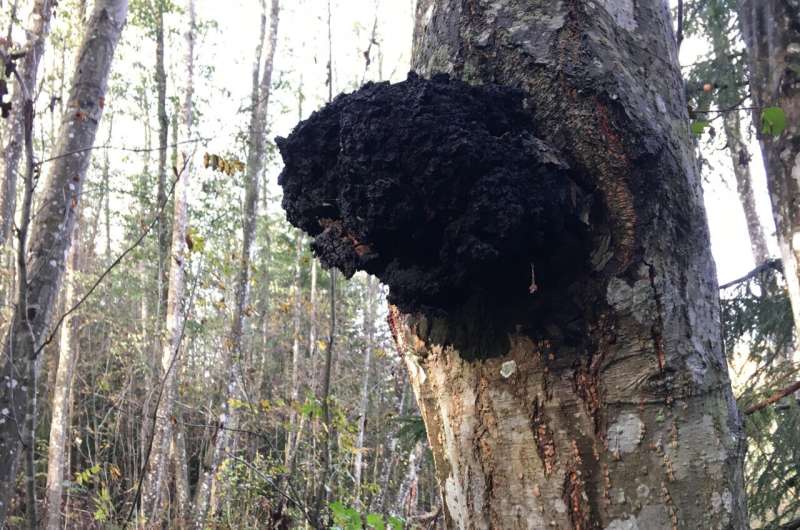Inonotus obliquus conks growing on Alnus incana have remarkable anticancer properties

A study led by researchers of the Estonian University of Life Sciences demonstrated that Inonotus obliquus, a fungal growth parasitizing the Alnus species, has comparable properties to the fungus growing on Betula species.
Inonotus obliquus is the fungus known to parasitize on Betula. Inonotus obliquus grows in the Northern Hemisphere and belongs to the family of Hymenochaetaceae in the order Hymenochaetales and causes stem rot on several broadleaved tree species.
In Estonia, the fungus grows primarily on Betula pendula, Betula pubescens, Alnus incana and Alnus glutinosa. Sterile conks of I. obliquus contain bioactive compounds known to have anti-cancer effects that act against the proliferation of cells of leukemia and lung and colon adenocarcinoma, hepatocellular carcinoma of the liver, oral epidermoid carcinoma and prostate cell carcinoma.
The bioactive compounds extracted from the I. obliquus, especially betulin, betulinic acid and inotodinol, inhibit the development of cancer cells. Previous studies have concentrated on the I. obliquus on birch trees, but it is not known whether the conks parasitizing on other tree species can offer equivalent properties.
The current study is the first to determine the bioactive compounds of the I. obliquus parasitizing on alder species. The results demonstrate convincingly that conks of I. obliquus parasitizing on A. incana, which is growing well in Estonia, contain betulin, inotodiol and lanosterol to a similar extent as I. obliquus on B. pendula.
Surprisingly, the A. incana conks contained even up to 30 times more betulinic acid than the conks parasitizing on B. pendula, 474–635 µg/g and 20–132 µg/g, respectively. The conks parasitizing on gray alder contained more beta-glucans, polyphenols and flavonols compared to the conks on silver birch. However, betulinic acid, betulin and inotodiol are more important in terms of anti-cancer effect.
Therefore, there is no substantive difference whether I. obliquus grows on a gray alder or a silver birch. However, further research is still needed to establish the potential effect of I. obliquus conks on alder on various cancer cell lines. Preliminary research also suggests the possibility that I. obliquus may have other valuable properties, such as effects on the immune system.
So what is the importance of the research for forestry and landowners? Alder is growing well in Estonia. It would increase the still comparatively low economic value of gray alder generally considered suitable mostly for firewood by cultivating this host I. obliquus and would offer landowners, especially small landowners, an opportunity to earn.
The article is not calling for mass inoculation of trees with a pathogenic fungus. The risks and best practices for inoculating trees need to be researched before a tree inoculation campaign, and only then one can proceed to cultivation. The study shows that gray alder is not a worthless tree species, but rather an important resource that can be valued in many ways.
The research is published in Biomolecules.
More information: Rein Drenkhan et al, Comparative Analyses of Bioactive Compounds in Inonotus obliquus Conks Growing on Alnus and Betula, Biomolecules (2022). DOI: 10.3390/biom12091178
Provided by Estonian Research Council




















